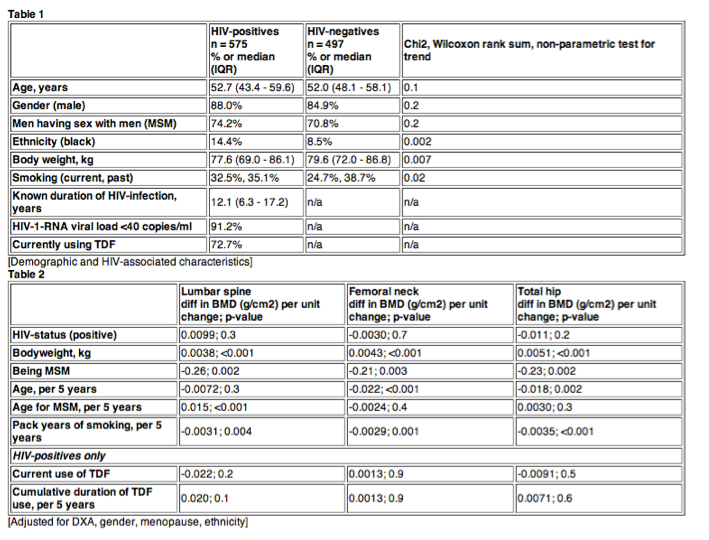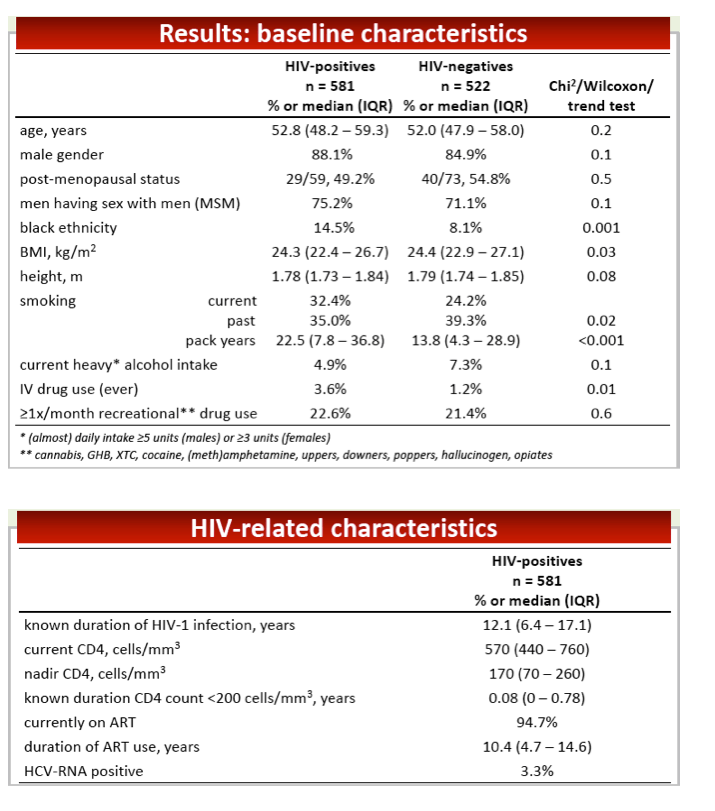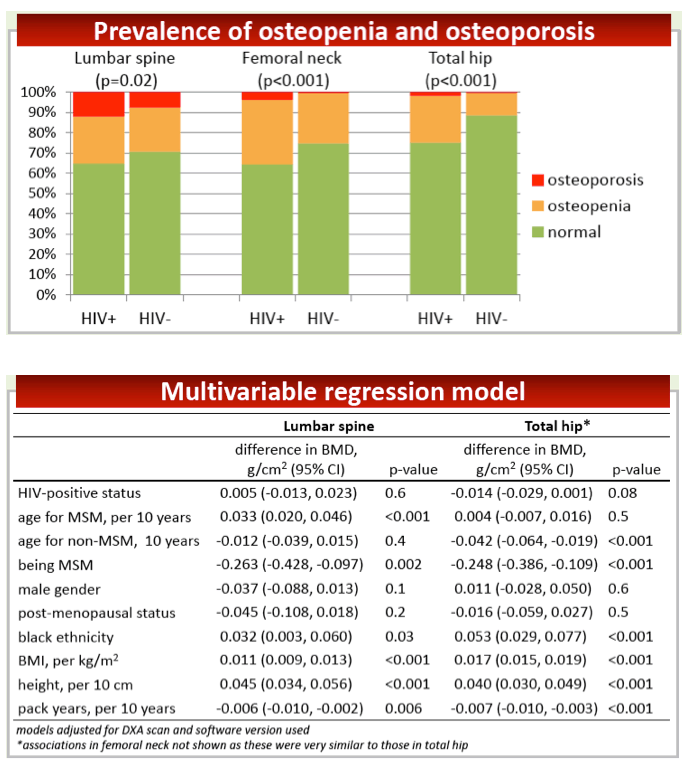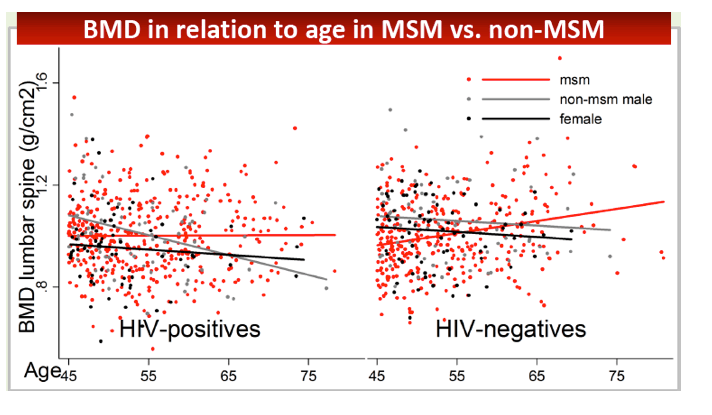 |
 |
 |
| |
Bone Loss Worse in HIV+ vs HIV-Neg, Lower Body Weight Predicts Bone Loss in MSM: "Prevalence and determinants of reduced bone mineral density in aging HIV-1-positive and HIV-negative individuals" in AGEhIV Cohort Amsterdam
|
| |
| |
Reported by Jules Levin
EACS - European AIDS Conference 2013 Oct 16-19 Brussels, Belgium

K.W. Kooij1,2, F.W. Wit1,2, P.H. Bisschop1, J. Schouten1,2, I.G. Stolte3, M. Prins3, M. van der Valk1, B.L. van Eck-Smit1, P. Lips4, P. Reiss1,2 on behalf of the AGEhIV cohort study group
1 Academic Medical Center 2 Amsterdam Institute for Global Health and Development 3 Public Health Service Amsterdam 4 VU University Medical Center, Amsterdam, the Netherlands
CONCLUSIONS
We confirm a higher prevalence of osteopenia/osteoporosis in older HIV-1-positive individuals with predominantly suppressed viremia on cART, than in uninfected persons of comparable age. After adjustment for BMI and smoking, being HIV-positive was no longer independently associated with lower BMD. Surprisingly, in MSM, regardless of HIV-status, the expected relationship between older age and lower BMD was not observed. In fact an opposite trend was seen which could not be explained by differences in measured behavioral or other characteristics. This may suggest the presence of an as yet unknown factor which has negatively impacted bone health amongst the younger MSM in our cohort.
Program Abstract
Reduced Bone Mineral Density (BMD) is Largely Explained by Lower Body Weight in HIV-positive Individuals and More Pronounced in Younger Men Having Sex with Men (MSM), Regardless of HIV-status
Objectives: Current understanding of the contribution of HIV and ART, most notably tenofovir (TDF), to bone loss, is hampered by the lack of comparable HIV-uninfected control group in many studies. We compared lumbar spine, total hip and femoral neck BMD by dual-energy X-ray absorptiometry (DXA) at study enrolment in HIV-positive and HIV-negative participants, ≥45 years, of the ongoing prospective AGEhIV cohort study.
Methods: Multivariable linear regression with multiple imputation for missing values was used to investigate associations with HIV-infection and ART, adjusting for traditional risk factors and DXA-software changes during the course of the study.
Results: Demographic and HIV-associated characteristics are shown in Table 1. Prevalence of osteoporosis or low BMD for age was higher in HIV-infected (14.4 vs. 8.1%, p=0.001). After adjustment for age, gender, menopausal status, ethnicity and DXA-software changes, HIV-infection remained significantly associated with lower femoral neck and total hip BMD (-0.020g/cm2, p=0.02 and -0.030g/cm2, p=0.001), but not with lumbar spine BMD. Upon further adjustment for bodyweight the association with HIV was no longer significant. A strong interaction was observed between age and being MSM: in non-MSM older age was associated with lower BMD, whereas in MSM this association was not present or even reversed, independent of HIV-status and traditional risk factors (Table 2). In those with HIV no significant association was found between cumulative or current use of TDF and BMD at any site.
Conclusion: We confirmed a high prevalence of osteoporosis and low BMD for age in HIV-positives, but also found a high prevalence in otherwise comparable uninfected persons.
Reduced BMD was not independently associated with HIV or TDF use, but could largely be explained by lower average bodyweight. Lower BMD associated with younger age in MSM needs further investigation and may be the result of unmeasured lifestyle and behavioral factors.

BACKGROUND
An increased prevalence of osteopenia and osteoporosis has been reported in HIV-1-infected individuals.1 The pathogenesis of HIV-associated low bone mineral density (BMD) is most likely multifactorial. Contributing factors may be lower average body weight in HIV-positive individuals2, antiretroviral therapy (ART) and persistent inflammation. First initiation of ART has been associated with a reduction in BMD. This is more pronounced for regimens containing tenofovir disoproxil fumarate (TDF)3 and it is unclear whether this effect persists4. A limitation of many studies conducted to date is the lack of a comparable HIV-uninfected control group.
1 Brown TT, Qaqish RB. AIDS. 20: 2165-74. 2006. 2 Bolland MJ, et al. J Clin Endocrinol Metab. 92: 4522-28. 2007. 3 McComsey GA, et al. JID. 203:1791-801. 2011. 4Bolland MJ, et al. J Clin Endocrinol Metab. 96: 2721-2731. 2011.
OBJECTIVES
Objectives were to assess BMD and the prevalence of osteopenia/ osteoporosis in comparable cohorts of HIV-1-positive and HIV-negative individuals, aged ≥45 years and to investigate whether HIV-1 and HIV-related characteristics are independently associated with BMD.
METHODS
581 HIV-1-positive individuals were enrolled at a single center HIV-outpatient clinic. 522 HIV-negative participants, comparable regarding age, gender and ethnicity were recruited from the municipal health service sexually transmitted disease clinic. Bone mineral density of the lumbar spine (L1-L4), total hip and femoral neck was measured by dual-energy X-ray absorptiometry. Additional potential determinants of BMD were assessed by physical exam, standardized questionnaire and different laboratory tests. Historical ART- and other relevant HIV-associated data were available through the ATHENA cohort.
Prevalence of osteopenia/osteoporosis in all three locations was based on T-score in post-menopausal women and men ≥50. In pre-menopausal women and men <50 osteoporosis was considered present if Z-score was ≤-2 (low BMD for age). Determinants of BMD were assessed by multivariable linear regression analysis, using multiple imputation for missing covariates.



HIV-related characteristics and BMD
Analyzing the HIV-1-positive cohort separately, independent associations were observed between a longer duration of a CD4 count below 200 and lower BMD in the total hip (-0.008 g/cm2/yr, p=0.02) and between HCV-RNA positivity and lower BMD in total hip (-0.084 g/cm2, p=0.004) and femoral neck (-0.075 g/cm2, p=0.006). No independent association was found between known duration of HIV-1 infection, current or past use of TDF or protease inhibitors and reduced BMD in any of the three locations.
|
| |
|
 |
 |
|
|